<< Previous | Displaying results 2551-2600 of 6769 for "" | Next >>
On July 14, 1933, the Nazi dictatorship enacted the Law for the Prevention of Offspring with Hereditary Diseases. Individuals who were subject to the law were those men and women who “suffered” from any of nine conditions listed in the law: hereditary feeblemindedness, schizophrenia, manic-depressive disorder, hereditary epilepsy, Huntington’s chorea (a rare and fatal degenerative disease), hereditary blindness, hereditary deafness, severe physical deformity, and chronic alcoholism. Gerda D., a…
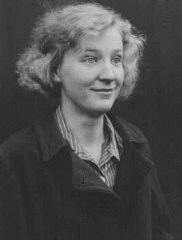
Axis leaders Adolf Hitler and Italian prime minister Benito Mussolini meet in Munich, Germany, 1940.
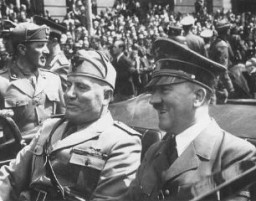
Slovak prime minister Vojtech Tuka (front row, standing) announces Slovakia's entry into the Axis alliance (initially Germany, Italy, and Japan; also joined by Hungary, Romania, and Bulgaria). Berlin, Germany, November 1940.
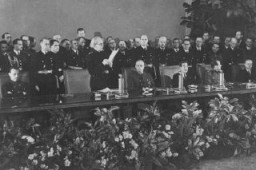
Bulgarian leader Bogdan Filov (standing) and German foreign minister Joachim von Ribbentrop (seated, center) during the signing of the Tripartite Pact. This treaty formally aligned Bulgaria with the Axis powers. Vienna, Austria, March 1, 1941.
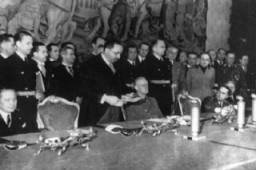
Adolf Eichmann, SS official in charge of deporting European Jewry. Germany, 1943.

Adolf Eichmann, SS official in charge of deporting European Jewry. Germany, 1940.
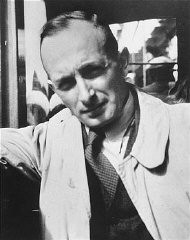
Defendant Adolf Eichmann takes notes during his trial in Jerusalem in 1961.
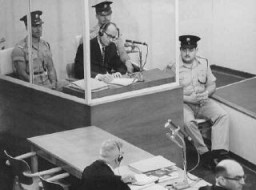
The prosecution team, including chief prosecutor and attorney general Gideon Hausner (bottom left), during Adolf Eichmann's trial. Jerusalem, Israel, May 30, 1961.
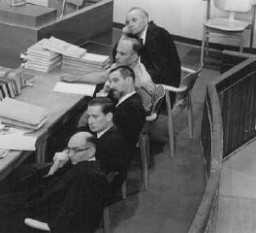
Henryk Ross testifies during Adolf Eichmann's trial. In addition to official duties as a photographer in the Department of Statistics in the Lodz ghetto, Ross secretly photographed scenes in the ghetto. To Ross' right is chief prosecutor Gideon Hausner, who holds some of Ross' photographs submitted as evidence. Jerusalem, Israel, May 2, 1961.
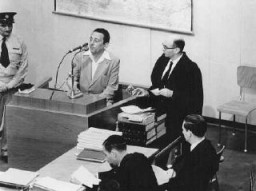
Witness Zivia Lubetkin Zuckerman testifies during the trial of Adolf Eichmann. Jerusalem, Israel. May 3, 1961.
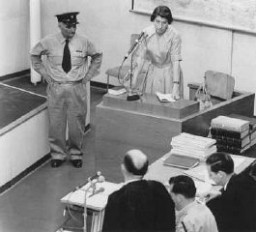
Jewish partisan and poet Abba Kovner, a survivor of the Vilna ghetto, testifies during Adolf Eichmann's trial. Jerusalem, Israel, May 4, 1961.
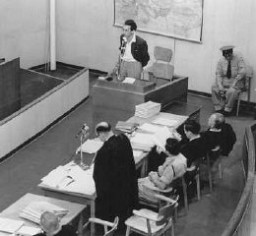
The presentation of evidence about defendant Ernst Kaltenbrunner at the International Military Tribunal trial of war criminals at Nuremberg. Germany, January 2, 1946. Ernst Kaltenbrunner (1903–1946) was Chief of the Reich Security Main Office (RSHA) and later Chief of the Security Police. In this second position, Kaltenbrunner controlled the Gestapo (German Secret State Police), Criminal Police, and Security Service (SD). He was a prime figure in the “Final Solution” in the last years of the war.
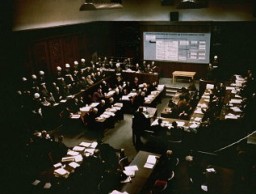
People gather in the street to read a special edition of the Nurnberger newspaper reporting the sentences handed down by the International Military Tribunal. Nuremberg, Germany, October 1, 1946.
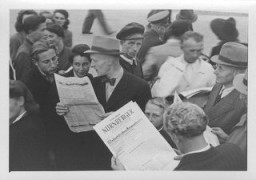
The defendants' dock and members of the defense counsel during the Doctors Trial. Nuremberg, Germany, December 9, 1946–August 20, 1947.
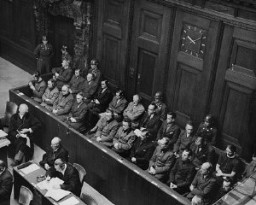
Defendant Karl Brandt testifies during the Doctors Trial. Nuremberg, Germany, December 9, 1946-August 20, 1947.
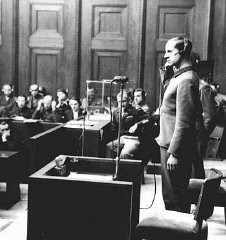
US Chief of Counsel Brigadier General Telford Taylor during the Doctors Trial. Nuremberg, Germany, December 9, 1946-August 20, 1947.
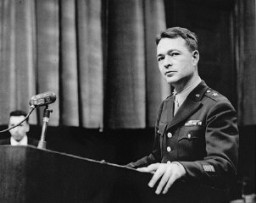
Fifteen-year-old Maria Dolezalova is sworn in as a prosecution witness at the RuSHA Trial. Dolezalova was among the children kidnapped by German forces after they destroyed the town of Lidice, Czechoslovakia. Nuremberg, October 30, 1947.
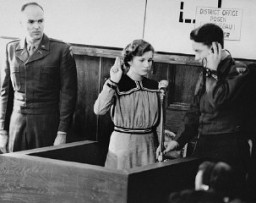
The defendants in the dock during the Justice Case, Case #3 of the Subsequent Nuremberg Proceedings. Nuremberg, Germany, 1947.
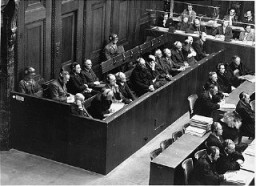
Defendant Otto Ohlendorf testifies on his own behalf at the Einsatzgruppen Trial, case #9 of the Subsequent Nuremberg Proceedings. October 9, 1947.
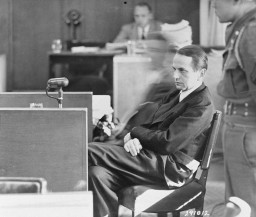
US Brigadier General Telford Taylor, chief counsel for war crimes, opens The Ministries Trial by reading the prosecution's opening statement. He charges Hitler's ministers with "crimes against humanity." Nuremberg, Germany, January 6, 1948.

Germans cheer Adolf Hitler as he leaves the Hotel Kaiserhof just after being sworn in as chancellor. Berlin, Germany, January 30, 1933.
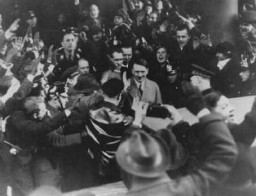
Members of the Hitler Youth march before their leader, Baldur von Schirach (at right, saluting), and other Nazi officials including Julius Streicher. Nuremberg, Germany, 1933.
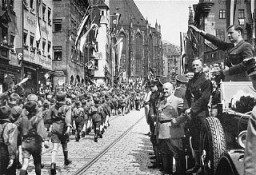
Jewish lawyers line up to apply for permission to appear before the Berlin courts. New regulations set forth in the Aryan Paragraph (a series of laws enacted in April 1933 to purge Jews from various spheres of state and society) allowed only 35 to appear before the court. Berlin, Germany, April 11, 1933.
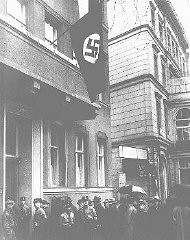
Crowds gather at Berlin's Opernplatz (opera square) for the burning of books deemed "un-German." Berlin, Germany, May 10, 1933.
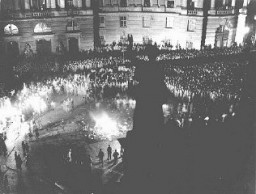
Reich Labor Service battalions parade before Hitler during the Nazi Party Congress. Nuremberg, Germany, September 8, 1937.
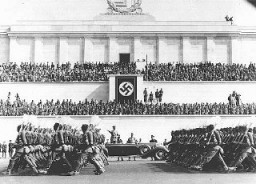
German adults attend a class in racial theory. Germany, date uncertain.
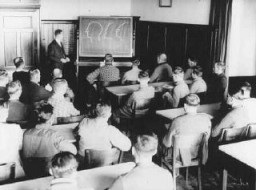
Family members say goodbye to a child through a fence at the ghetto's central prison where children, the sick, and the elderly were held before deportation to Chelmno during the "Gehsperre" action. Lodz, Poland, September 1942.
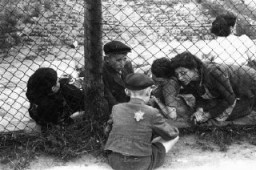
Two young brothers, seated for a family photograph in the Kovno ghetto. One month later, they were deported to the Majdanek camp. Kovno, Lithuania, February 1944. Pictured are Avram (5 years) and Emanuel Rosenthal (2 years). Emanuel was born in the Kovno ghetto. The children, who were deported in the March 1944 "Children's Action," did not survive. Their uncle, Shraga Wainer, who had asked George Kadish to take this photograph, received a copy of it from the photographer after the war in the Landsberg…
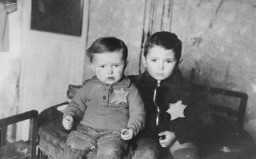
Jewish children sheltered by the Protestant population of the village of Le Chambon-sur-Lignon. France, 1941–44.
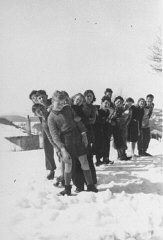
Father Bruno with Jewish children he hid from the Germans. Yad Vashem recognized Father Bruno as "Righteous Among the Nations." Belgium, wartime.
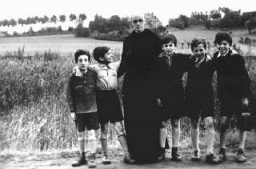
Two young cousins shortly before they were smuggled out of the Kovno ghetto. A Lithuanian family hid the children and both girls survived the war. Kovno, Lithuania, August 1943.

Sinaida Grussman was photographed in the Kloster Indersdorf children's center after the war. The picture was taken in an attempt to help locate surviving relatives. Such photographs of both Jewish and non-Jewish children were published in newspapers to facilitate the reunification of families. Germany, after May 1945.

Jewish orphans arrive at the Marseille railroad station, en route to Palestine as part of postwar Brihah movement. Marseille, France, March 25, 1948.
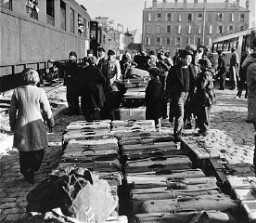
A dress worn by hidden child in Baarn, the Netherlands. The dress was donated to the United States Holocaust Memorial Museum in 2002 by Vera Waisvisz-Reiss.
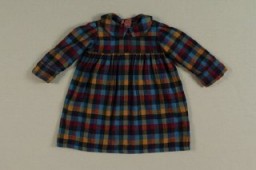
Two German Jewish families at a gathering before the Nazi rise to power. Only two people in this group survived the Holocaust. Germany, 1928.
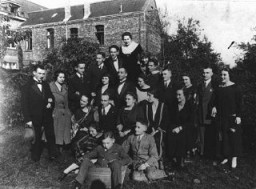
Young Jewish men and women pose for a photograph in the Piotrkow Trybunalski ghetto. Poland, 1940. Pictured from left to right are: Abram Zarnowiecki, Rozia Zarnowiecki, Mania Freiberger, Moniek, Rachel Zarnowiecki, and Chaim Zarnowiecki. All those pictured died in the Holocaust.
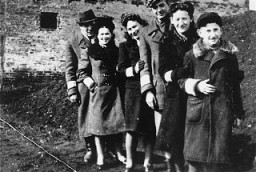
A brother and sisters, members of a Jewish family. One of the sisters pictured here, along with other family members, did not survive the Holocaust. Nove Zamky, Czechoslovakia, May 1944.
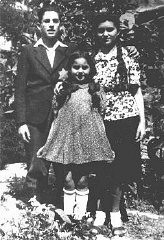
Portrait of members of a Hungarian Jewish family. They were deported to and killed in Auschwitz soon after this photo was taken. Kapuvar, Hungary, June 8, 1944.
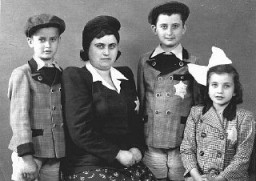
German Jews at forced labor in Dachau. Photo taken during an SS inspection. Dachau concentration camp, Germany, June 28, 1938.
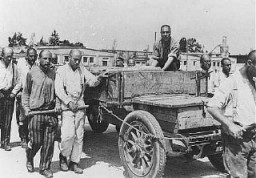
Newly arrived prisoners at the Buchenwald concentration camp. Buchenwald, Germany, 1938-1940.

Exterior view of barracks at the Ravensbrück concentration camp. Ravensbrueck, Germany, between May 1939 and April 1945.
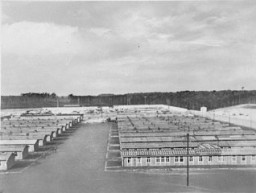
Jewish prisoners in the Drancy transit camp. France, between 1941 and 1944.

View of the stone quarry in the Gross-Rosen camp, where prisoners were subjected to forced labor. Gross-Rosen, Germany, 1940-1945.
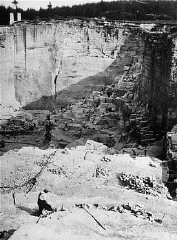
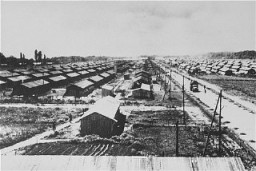
View through the barbed wire of the prisoner barracks in the Flossenbürg concentration camp. Flossenbürg, Germany, 1942.
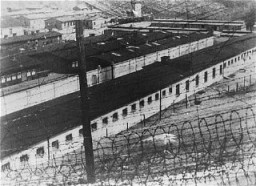
Shaving an inmate upon arrival at the Sachsenhausen concentration camp. Germany, February 1941.
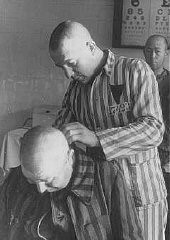
A sign outside the Breendonk transit camp warning that trespassers will be shot. Breendonk, Belgium, 1940-1944.
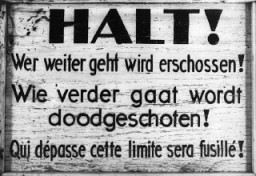
Forced labor in the quarry of the Mauthausen concentration camp. Austria, date uncertain.
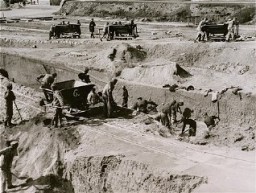
Deportation from the Westerbork transit camp. Members of the Jewish police are seen in the photograph. The Netherlands, 1943–44.
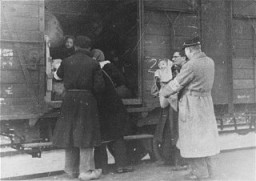
Jews from the Lodz ghetto are loaded onto freight trains for deportation to the Chelmno killing center. Lodz, Poland, 1942–44.
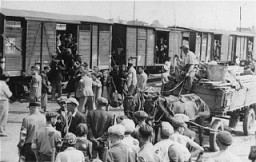
We would like to thank Crown Family Philanthropies, Abe and Ida Cooper Foundation, the Claims Conference, EVZ, and BMF for supporting the ongoing work to create content and resources for the Holocaust Encyclopedia. View the list of donor acknowledgement.